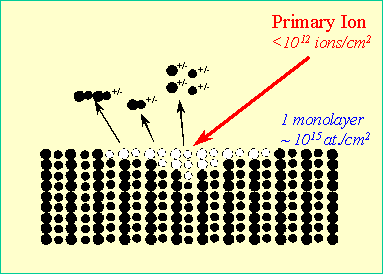|
Time-of-Flight
Secondary Ion Mass Spectrometry (ToF-SIMS) [Description]
[Instrument] [Sample
Requirement] [Application] Description
Principle of SIMS: In a SIMS experiment, a sample is bombarded with a primary ion beam of kinetic energy of 1-25 keV. Upon bombardment, the kinetic energy and momentum of the impinging ions are transferred to the sample via a collision cascade process. When the transferred recoil energy is higher than the surface binding energy, secondary particles are emitted from the surface. A very small fraction (<1%) of these particles consists of both positive and negative ions. The collection of these positive or negative ions by a mass spectrometer constitutes the basis of SIMS. A SIMS experiment can be carried out in the dynamic or static mode. In the dynamic mode, the incident ion current is high and consequently the surface is rapidly damaged and eroded away. Therefore, dynamic SIMS is used to provide in-depth distribution of elements (depth profiling). In static mode, the total incident ion density is kept below 1012 ions/cm2 (static conditions). In this case, only one per thousand of the surface atoms is directly bombarded by the primary ion (assuming a surface atom density of 1015 atoms/cm2 » 1 monolayer). The surface damage is negligible and the emitted secondary ions would contain not only atomic species but also molecular species (Fig. 1). Therefore, static SIMS is used to provide information about the molecular surface structure of materials.
ToF–SIMS:
ToF-SIMS uses the state-of-the art ToF mass spectrometer to detect the
secondary ions. It is optimized for static SIMS analysis. In the ToF-SIMS
experiment, a pulsed beam strikes a sample surface and the secondary
ions are extracted from the sample and accelerated into a field-free ToF
mass spectrometer with a common energy. If the initial kinetic energy is
neglected, the secondary ions will have the same kinetic energy E and
their velocity in the filed-free drift depends only on their mass:
where
q, m and v are respectively the charge, mass and velocity of the
secondary ions and V is accelerated voltage. If these ions travel to a
flight path (L) in the drift before reaching the detector, their
time-of-flight (t) is proportional to the square root of their mass:
Thus
the light ions will have higher velocity and will reach the detector
sooner than the heavier ones. In this way, secondary ions differing in
mass are separated according to their flight time. The time difference
between the primary ion pulse (start pulse) and the pulse produced by
secondary ion at the detector (stop pulse) is measured and converted to
an amplitude signal via a time-to-digital converter (TDC). The pulses
are then sorted to produce mass histogram. ToF-SIMS
experiments can be operated in three different modes and provide
different information: ¨
Surface
spectroscopy mode: In this
case, ToF-SIMS analysis is carried out under static conditions. The
secondary ions coming from the sample surface are very characteristic of
the original surface structure and provide a “fingerprint” of the
molecular structure of the material. Static ToF-SIMS is very surface
sensitive and only probes the top one or two atomic layers (< 1 nm)
of the material. ¨
Surface
imaging mode: By scanning a
finely focused primary ion beam over the surface, the mass resolved ion
images can be obtained. These ion images provide a two dimensional
distribution of different chemical species on surface. ¨
Depth
profiling mode: In contrast
to static mode, a high ion current is used to sputter the material. The
in-depth distribution of elements can be obtained in this case. ToF-SIMS
is extremely sensitive, with detection limit down to ppb level. However,
it has a difficulty in providing quantitative data. Reference [1]
C.-M. Chan and L.T. Weng, Reviews in Chemical Engineering,
16 (2000) 341-408 [Go
Top] As
ToF-SIMS experiments are carried out under ultra-high vacuum, the
samples to be analysed must be vacuum compatible. Both conductive and
insulating materials can be analysed. *
ToF-SIMS
analysis on organic silicone * ToF-SIMS analysis on polymer blend [Go
Top]
|
